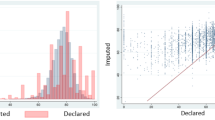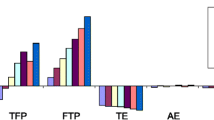Abstract
This study analyses the cause of the slowdown in Japan’s TFP growth during the 1990s. Many preceding studies, examining the issue at the macro- or industry-level, have found that the slowdown was primarily due to the stagnation in TFP growth in the manufacturing sector. Using firm level panel data covering the entire sector, we investigate the causes of the TFP slowdown and find that the reallocation of resources from less efficient to more efficient firms was very slow and limited. This “low metabolism” seems to be an important cause for the slowdown in Japan’s TFP growth.
Similar content being viewed by others
References
Ahearne, A. G. and N. Shinada (2004) “Zombie Firms and Economic Stagnation in Japan”, paper presented at the University of Michigan CGP Conference, Macro/Financial Issues and International Economic Relations: Policy Options for Japan and the United States.
Ahn, S., K. Fukao and H. U. Kwon (2004) “The Internationalization and Performance of Korean and Japanese Firms: An Empirical Analysis Based on Micro Data”, Seoul Journal of Economics, Vol. 17, No. 4, pp. 439–482.
Aw, B. Y., X. Chen and M. J. Roberts (2001) “Firm-level Evidence on Productivity Differentials and Turnover in Taiwanese Manufacturing”, Journal of Development Economics, Vol. 66, No. 1, pp. 51–86.
Baily, M. N., C. Hulten and D. Campbell (1992) “Productivity Dynamics in Manufacturing Plants”, Brookings Papers on Economics Activity: Microeconomics, Vol. 2, pp. 187–249.
Barnes, M., J. Haskell and M. Maliranta (2001) “The Sources of Productivity Growth: Micro-Level Evidence for the OECD”, paper presented at the OECD Workshop on Firm-Level Statistics, November 26–27, 2001.
Bartelsman, E. J. and M. Doms (2000) “Understanding Productivity: Lessons from Longitudinal Microdata”, Journal of Economic Literature, Vol. 38, No. 3, pp. 569–594.
Basu, S. and M. S. Kimball (1997) “Cyclical Productivity with Unobserved Input Variation”, NBER Working Paper, No. 5915.
Caballero, R. J., T. Hoshi and A. K. Kashyap (2004) “Zombie Lending and Depressed Restructuring in Japan”, paper presented at Hitotsubashi University, Macro-Money Workshop.
Cabinet Office, Government of Japan (2002) Annual Report on the Japanese Economy and Public Finance 2001–2002: No Gains without Reforms II. Tokyo: Cabinet Office, Government of Japan.
Domar, E. (1961) “On the Measurement of Technological Change”, Economic Journal, Vol. 71, No. 284, pp. 709–729.
Foster, L., J. Haltiwanger and C. J. Krizan (2001) “Aggregate Productivity Growth: Lessons from Microeconomic Evidence”, in C. R. Hulten, E. R. Dean and M. J. Harper (eds), New Contributions to Productivity Analysis, Chicago: The University of Chicago Press, pp. 303–372.
Fukao, K. and H. U. Kwon (2003) “Nippon no Seisansei to Keizai Seicho (The Productivity and Economic Growth of Japan)”, paper presented at the Semi-annual Conference of the Japan Economic Association, Oita.
- and - (2004) “Nippon no Seisansei to Keizai Seicho: Sangyo Reberu Kigyo Reberu Deta niyoru Jissho Bunseki (The Productivity and Economic Growth of Japan: Empirical Analysis based on Industry-Level and Firm-Level Data)”, Keizai Kenkyu, Vol. 55, No. 3, pp. 261–284.
-, T. Inui, H. Kawai and T. Miyagawa (2004) “Sectoral Productivity and Economic Growth in Japan, 1970–98; An Empirical Analysis Based on the JIP Database”, in T. Ito and A. K. Rose (eds), Growth and Productivity in East Asia, National Bureau of Economic Research-East Asia Seminar on Economics, Vol. 13, Chicago: University of Chicago Press, pp. 177–227.
-, T. Miyagawa, H. Kawai and T. Inui (2003) “Sangyo Betsu Seisansei to Keizai Seicho: 1970–98 (Sectoral Productivity and Economic Growth: 1970–98)”, Keizai Bunseki, No. 170, Economic and Social Research Institute, Cabinet Office, Government of Japan, Tokyo.
Fukao, M. (2003) “Choki Fukyo no Shuin wa Juyo Fusoku ni Aru (The Major Cause of the Long Recession is the Lack of Demand)”, in K. Iwata and T. Miyagawa (eds), Ushinawareta Junen no Shinin wa Nanika (What is the Real Cause of the Lost Decade), Tokyo: Toyo Keizai Shinpo Sha, pp. 17–20.
Good, D. H., M. I. Nadiri and R. C. Sickles (1997) “Index Number and Factor Demand Approaches to the Estimation of Productivity”, in M. H. Pesaran and P. Schmidt (eds), Handbook of Applied Econometrics: Vol. 2. Microeconomics. Oxford, England: Basil Blackwell, pp. 14–80.
Griliches, Z. and H. Regev (1995) “Productivity and Firm Turnover in Israeli Industry: 1979–1988”, Journal of Econometrics, Vol. 65, No. 1, pp. 175–203.
Hattori, T. and M. Hironobu (2000) “Sangyo Betsu no Gijutsu Shinporitsu no Keisoku to Keizai Seicho no Yoinbunkai—1970 Nendai Kohan Iko no Jisshokenkyu (Measuring Technological Progress and Factor Analysis of Economic Growth in Japanese Industry)”, Denryoku Keizai Kenkyu, Vol. 44, pp. 1–16.
Hayashi, F. and E. C. Prescott (2002) “The 1990s in Japan: A Lost Decade”, Review of Economic Dynamics, Vol. 5, No. 1, pp. 206–235.
Inui, T. and H. U. Kwon (2004) “Tembo: Nihon no TFP Joshoritsu wa 1990-nendaini oite Doredake Teika Shitaka (Survey: Did the TFP Growth Rate in Japan Decline in the 1990s),” ESRI Discussion Papers Series, No. 115.
Jorgenson, D. W. and K. Motohashi (2003) “The Role of Information Technology in the Economy: Comparison between Japan and the United States”, prepared for RIETI/KEIO Conference on Japanese Economy: Leading East Asia in the 21st Century? Keio University.
- and - (2004) “Information Technology and the Japanese Economy”, prepared for 17th Annual TRIO Conference: Productivity, Keio University, 2004.
Kawamoto, T. (2004) “What Do the Purified Solow Residuals Tell Us about Japan’s Lost Decade?”, Bank of Japan IMES Discussion Paper Series, No. 2004-E-5, Bank of Japan, Tokyo.
Masuda, M. (2000) “Shihon Shutokku Tokei no Mikata: Shijo Hyoka Shihon Sutokku no Shisan (A Perception of Japan’s Capital Stock Statistics: A Trial Calculation of Capital Stock in Market Value)”, Research and Statistics Department Discussion Paper Series, No. 00-5, Bank of Japan, Tokyo.
Miyagawa, T. (2003) “Ushinawareta Junen to Sangyo Kozo no Tenkan (The Lost Decade and Structural Change)”, in K. Iwata and T. Miyagawa (eds), Ushinawareta Junen no Shinin wa Nanika (What is the Real Cause of the Lost Decade), Tokyo: Toyo Keizai Shinpo Sha, pp. 39–61.
Morikawa, M. (2004) “Are Japanese Firms ‘Polarizing’ in their Performances?–An Empirical Test Based on the Micro-Data of the Basic Survey on Business Activities by Enterprises–(Nihon Kigyo no Gyoseki wa ‘Nikyokuka’ Shite Iru ka? — Kigyo Katsudo Kihon Chosa Maikuro Deita niyoru Kensho —),” Chosa Working Paper, No. WP04–05, Research Section, Economic and Industrial Policy Bureau, Ministry of Economy, Trade and Industry, Government of Japan, Tokyo.
Morrison, C. J. (1993) A Microeconomic Approach to the Measurement of Economic Performance: Productivity Growth, Capacity Utilization, and Related Performance Indicators, New York: Springer-Verlag.
Nishimura, K. G. and K. Minetaki (2003) Joho Gijutsu Kakushin to Nihon Keizai (Innovation in Information Technology and the Japanese Economy), Tokyo: Yuhikaku.
-, T. Nakajima and K. Kiyota (2005) “Does the Natural Selection Mechanism Still Work in Severe Recessions? Examination of the Japanese Economy in the 1990s”, Journal of Economic Behavior and Organization, Vol. 58, No. 1, pp. 53–78.
Shinada, N. (2003) “Decline in Productivity in Japan and Disparities between Firms in the 1990s: An Empirical Approach Based on Data Envelopment Analysis”, Development Bank of Japan Research Report, No. 38, Development Bank of Japan, Tokyo.
Yoshikawa, H. (2003) “Hayashi Ronbun eno Komento: Sugitaru wa Nao Oyobazaru ga Gotoshi !? (Comment on Hayashi Paper: Too Much is as Bad as Too Little !?)”, in K. Iwata and T. Miyagawa (eds), Ushinawareta Junen no Shinin wa Nanika (What is the Real Cause of the Lost Decade), Tokyo: Toyo Keizai Shinpo Sha, pp. 21–24.
- and Matsumoto, K. (2001) “Soron: 1990-nendai no Nichibei Keizai (An introduction: The Japanese and the U.S. Economy in the 1990s)”, Financial Review, Vol. 58, pp. 1–17.
Author information
Authors and Affiliations
Additional information
We are grateful to Fumio Hayashi, the discussant, Kiyohiko G. Nishimura, other participants of the CIRJE-TCER Macro Conference, and the anonymous referee of this journal for their comments and suggestions on a preliminary version of this paper. We gratefully acknowledge the Grant-in-Aid from the Ministry of Education and Technology for the project “Empirical Analysis of Economic Institutions (grant no. 12)”
Rights and permissions
About this article
Cite this article
Fukao, K., Kwon, H.U. Why Did Japan’s TFP Growth Slow Down in the Lost Decade? An Empirical Analysis Based on Firm-Level Data of Manufacturing Firms. JER 57, 195–228 (2006). https://doi.org/10.1111/j.1468-5876.2006.00359.x
Accepted:
Published:
Issue Date:
DOI: https://doi.org/10.1111/j.1468-5876.2006.00359.x




